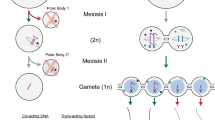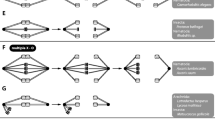Abstract
Two alternative matrix “solutions” of drive in Drosophila males with sc 4-sc 8 as studied by Peacock (1965) poses questions concerning meiosis in such flies. The two solutions are based primarily on the observations that sc 4-sc 8 males with low levels of X, Y non-disjunction produce twice as many female-as male offspring; that 50% of the sperm in this Drosophila line may be dysfunctional; that at all levels of non-disjunction studied, the difference between the % of female and male offspring produced by normal disjunction is about 33; and finally that, among non-disjunction types, nullo sperm werer covered more frequently than those with X and Y.
The first matrix solution suggests a new model involving production of one “infertile”- and one “fertile” daughter cell at meiosis 1 in 1/3 of the cases and at meiosis 2 in the other 2/3. The second solution is already well known and would require the production of one fertile and one infertile secondary cyte at meiosis 1, in all cases. The unique feature of the first solution is that all four anaphase 2 poles (or genes) are present in primary spermatocytes as primordia. Two of these would predetermine fertility and two, infertility; and by assuming a random 2-by-2 assortment of these four poles at M1, together with physical binding of one of them with an X-or a Y chromatid, all known sc 4-sc 8 data as listed above, can be explained. The second model is necessarily more cumbersome, as it is difficult to account for a 2/1, female/male, ratio being produced at one cell division (meiosis 1).
Discussed are possible applications of the segregation matrix method as a tool for determining degrees of freedom (complexity) in any biological system; implication of the models for segregation distorter (SD), for heterozygous translocations analyzed in Drosophila by Glass (1935) and by Zimmering (1955), and in other known or suspected cases of drive.
Similar content being viewed by others
References
Chandley, A. C. (1965). Application of the “distributive pairing” hypothesis to problems of segregation in translocation heterozygotes of Drosophila melanogaster. Genetics 52: 247–258.
Cooper, K. W. (1949). The cytogenetics of meiosis in Drosophila. Mitotic and meiotic autosomal chiasmata without crossing over in the male. J. Morph. 84: 81–122.
Denell, R. E. & B. H. Judd (1969). Segregation distorter in D. melanogaster males: an effect of female genotype on recovery. Molec. Gen. Genetics 105: 262–274.
Douglas, L. T. (1968a). Meiosis IV: Segregation from interchange multivalents as a Markov process. Genetica 39: 429–455.
Douglas, L. T. (1968b). Meiosis V: Matric and path coefficient solutions of tri-and quadrivalents. Genetica 39: 456–496.
Douglas, L. T. (1971). Meiosis IX: Segregation matrix analyses of meiotic drive and non-random disjunction in Drosophila. (MS).
Douglas, L. T. & S. J. Geerts (1966). Meiosis II: A modified affinity model in mice. Genetica 37: 511–542.
Douglas, L. T., M. E. van Meekeren & S. J. Geerts (1970). Characteristics of meiotic drive in spa pol/+Drosophila melanogaster males. (MS).
Gabritschevsky, E. & C. B. Bridges (1928). The giant mutation in Drosophila melanogaster. Part II. Physiological aspects of the giant race. The giant “caste”. Z. indukt. Abstamm.-u. Vererb. Lehre 46: 248–284.
Gershenson, S. (1933). Studies on the genetically inert region of the X-chromosome of Drosophila. I. Behavior of an X-chromosome deficient for a part of its inert region. J. Genet. 28: 297–313.
Glass, H. B. (1935). A study of factors influencing chromosomal segregation in translocations of Drosophila melanogaster. Univ. Missouri Res. Bulletin 231: 1–28.
Hanks, G. D. (1969). A deviant sex ratio in Drosophila melanogaster. Genetics 61: 595–606.
Hartl, D. L., Y. Hiraizumi & J. F. Crow (1967). Evidence for sperm dysfunction as the mechanism of segregation distortion in Drosophila melanogaster. Proc. Nat. Acad. Sci. (Wash) 58: 2240–2245.
Hiraizumi, Y. & K. Nakazima (1967). Deviant sex ratio associated with segregation distortion in Drosophila melanogaster. Genetics 55: 681–697.
Huettner, A. F. (1930). The spermatogenesis of Drosophila (sic!) melanogaster. Z. Zellforsch. u. mikroskop. Anat. 11: 615–637.
Kataoka, Y. (1967). A genetic system modifying Segregation Distortion in a natural population of Drosophila melanogaster in Japan. Japan. J. Genetics 42: 327–337.
Mange, E. J. (1968). Temperature sensitivity of segregation distortion in Drosophila melanogaster. Genetics 58: 399–413.
Matsuura, H. (1938). Chromosome studies on Trillium kamtschaticum Pall. VII. Additional evidence for the neo-two-plane theory of bivalent constitution. Cytologia 9: 78–87.
Novitski, E. (1951). Non-random disjunction in Drosophila. Genetics 36: 267–280.
Novitski, E. (1967). Non-random disjunction in Drosophila. Ann. Rev. Genetics 1: 71–86.
Novitski, E., W. J. Peacock & J. Engel (1965). Cytological basis of “sex ratio” in Drosophila melanogaster. Science 148: 516–517.
Novitski, E. & I. Sandler (1957). Are all products of spermatogenesis functional? Proc. Nat. Acad. Sci. (Wash.) 43: 318–324.
Pauling, L. & E. B. Wilson (1935). Introduction to quantum mechanics. McGraw-Hill Book Co., Inc. New York.
Peacock, W. J. (1965). Non-random segregation of chromosomes in Drosophila males. Genetics 51: 555–571.
Peacock, W. J. & J. Erickson (1965). Segregation-distortion and regularly non-functional products of spermatogenesis in Drosophila melanogaster. Genetics 51: 313–328.
Policansky, D. & J. Ellison (1970). “Sex ratio” in Drosophila pseudoobscura: spermiogenic failure. Science 169: 888–889.
Sandler, I. & G. Braver (1954). The meiotic loss of unpaired chromosomes in Drosophila melanogaster. Genetics 39: 365–377.
Sandler, L. & Y. Hiraizumi (1959). Meiotic drive in natural populations of Drosophila melanogaster. II. Genetic variation at the Segregation-Distorter locus. Proc. Nat. Acad. Sci. (Wash.) 45: 1412–1422.
Sandler, L. & A. Rosenfeld (1962). A genetically induced, heritable modification of segregation-distortion in Drosophila melanogaster. Canad. J. Genet. Cytol. 4: 453–457.
Sidorov, B. N., N. N. Sokolov & I. E. Trofimov (1936). Crossing-over in heterozygoten Inversionen. Genetica 18: 291–312.
Sturtevant, A. H. & G. H. Beadle (1936). The relations in inversions in X-chromosome of Drosophila melanogaster to crossing over and disjunction. Genetics 21: 554–604.
Syrkin, Y. K. & M. E. Dyatkina (1950). Structure of molecules and the chemical bond. Dover Publ. Inc., New York.
Yanders, A. F., J. F. Brewen, W. J. Peacock & D. J. Goodchild (1968). Meiotic drive and visible polarity in Drosophila spermatocytes. Genetics 59: 245–253.
Zimmering, S. (1955). A genetic study of segregation in a translocation heterozygote in Drosophila. Genetics 40: 809–825.
Zimmering, S., J. M. Barnabo, J. Femino & G. L. Fowler (1970). Progeny: sperm ratios and segregation distorter in Drosophila melanogaster. Genetica 41: 61–64.
Zimmering, S. & G. L. Fowler (1968). Progeny: sperm ratios and non-functional sperm in Drosophila melanogaster. Genet. Res. 12: 359–363.
Author information
Authors and Affiliations
Rights and permissions
About this article
Cite this article
Douglas, L.T. Meiosis VIII: Segregation matrix methods applied to meiotic drive in Drosophila melanogaster males with an SC 4-SC 8 inverted X. Genetica 42, 104–128 (1971). https://doi.org/10.1007/BF00154843
Received:
Accepted:
Issue Date:
DOI: https://doi.org/10.1007/BF00154843




